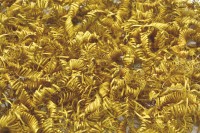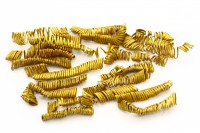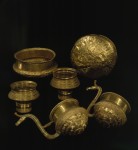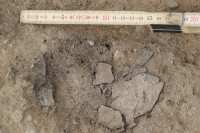 An unprecedented cache 2,000 gold spirals from the Bronze Age has been discovered in a field near the town of Boeslunde on the Danish island of Zealand. Bronze Age spirals have been found before — gold ones in the Syke hoard in Germany, for example, and bronze ones in Poland — but these are the first to be discovered in Denmark.
An unprecedented cache 2,000 gold spirals from the Bronze Age has been discovered in a field near the town of Boeslunde on the Danish island of Zealand. Bronze Age spirals have been found before — gold ones in the Syke hoard in Germany, for example, and bronze ones in Poland — but these are the first to be discovered in Denmark.
 The spirals are made of very thin, very pure, flat gold thread just 0.1 millimeter thick and up to three centimeters (1.18 inches) long. Some of the spirals are complete at up to three centimeters long; some are in small fragments. All totalled, the gold weight of the spirals is between 200 and 300 grams (7-10 ounces). Two gilded fibulae found with the spirals date the find to 900-700 B.C.
The spirals are made of very thin, very pure, flat gold thread just 0.1 millimeter thick and up to three centimeters (1.18 inches) long. Some of the spirals are complete at up to three centimeters long; some are in small fragments. All totalled, the gold weight of the spirals is between 200 and 300 grams (7-10 ounces). Two gilded fibulae found with the spirals date the find to 900-700 B.C.
 In 2013, metal detectorists Christian Albertsen and his uncle Hans Henrik Hansen found four gold bangles, so-called oath rings, in the same Boeslunde field. Six other gold oath rings had been unearthed in the field earlier (each individually at different times, not as part of a hoard) and in the 1800s local farmers found a group of six elaborately decorated gold bowls, two of which have incredibly thin gold wire wound around elongated handles crafted to look like stylized dragons. The total weight of the 10 oath rings found in Boeslunde is 3.5 kilos (7.7 pounds). The set of bowls weighs another kilo (2.2 pounds). That makes Boeslunde the richest gold field of the Northern European Bronze Age, and there may well be more to find.
In 2013, metal detectorists Christian Albertsen and his uncle Hans Henrik Hansen found four gold bangles, so-called oath rings, in the same Boeslunde field. Six other gold oath rings had been unearthed in the field earlier (each individually at different times, not as part of a hoard) and in the 1800s local farmers found a group of six elaborately decorated gold bowls, two of which have incredibly thin gold wire wound around elongated handles crafted to look like stylized dragons. The total weight of the 10 oath rings found in Boeslunde is 3.5 kilos (7.7 pounds). The set of bowls weighs another kilo (2.2 pounds). That makes Boeslunde the richest gold field of the Northern European Bronze Age, and there may well be more to find.
 It was the oath ring discovery that spurred the discovery of the spirals. After the bangles were found, the West Zealand Museum undertook an excavation of the field. It was a small search area — only a few square meters of soil were dug up — and archaeologists found a small group of three or four spiral fragments bundled together. Christian Albertsen, the finder of the oath rings who was assisting in the dig, brought one of the spirals to a jeweler. He confirmed that it was made of gold, not brass, so the Zealand Museum decided to dig again in the same spot, this time enlisting the aid of experts from the National Museum of Denmark.
It was the oath ring discovery that spurred the discovery of the spirals. After the bangles were found, the West Zealand Museum undertook an excavation of the field. It was a small search area — only a few square meters of soil were dug up — and archaeologists found a small group of three or four spiral fragments bundled together. Christian Albertsen, the finder of the oath rings who was assisting in the dig, brought one of the spirals to a jeweler. He confirmed that it was made of gold, not brass, so the Zealand Museum decided to dig again in the same spot, this time enlisting the aid of experts from the National Museum of Denmark.
 During this second excavation archaeologists made the bulk of the find: a large pile of gold coils. Underneath and around the pile were shards of a grey-black material. Analysis in the National Museum’s lab identified these black chunks as birch bark tar, a substance used by prehistoric peoples, including the Neanderthals, as an all-purpose adhesive starting 80,000 years ago. The copper axe found with the 5,300-year-old iceman Otzi was hafted with birch bark tar. The tar chunks found under the spirals bore the imprint of a flat wooden surface on one side of the flakes and the imprint of animal skin on the other, which indicates the tar was used to glue a leather lining into a wooden box. Archaeologists think the spirals were placed inside a jewelry box or dress chest before being buried in the Boeslunde field.
During this second excavation archaeologists made the bulk of the find: a large pile of gold coils. Underneath and around the pile were shards of a grey-black material. Analysis in the National Museum’s lab identified these black chunks as birch bark tar, a substance used by prehistoric peoples, including the Neanderthals, as an all-purpose adhesive starting 80,000 years ago. The copper axe found with the 5,300-year-old iceman Otzi was hafted with birch bark tar. The tar chunks found under the spirals bore the imprint of a flat wooden surface on one side of the flakes and the imprint of animal skin on the other, which indicates the tar was used to glue a leather lining into a wooden box. Archaeologists think the spirals were placed inside a jewelry box or dress chest before being buried in the Boeslunde field.
It’s not clear how the coils were used or for what purpose. Given the high quantity of sacrificed gold found in the field, the location may have held ritual importance.
Flemming Kaul from the National Museum also believes that the area had some sort of religious significance as a place where Bronze Age worshippers carried out rituals and sacrifices to the higher powers.
“Maybe the priest king had a golden bracelet around his wrist, and the gold spirals adorned his cape or his hat, where during rituals they shone like the sun. The sun was one of the holy symbols in the Bronze Age and gold was presumably seen as having some sort of particular magic power. It is colored like the sun, it shines like the sun, and because gold lasts forever, it was also seen as containing some of the Sun’s power,” Kaul said.
The Zealand Museum and the National Museum plan to continue to excavate the site in cooperation with amateur archaeologists/metal detectorists like Christian Albertsen who has been so instrumental in the momentous discoveries made in Boeslunde. The gold spirals will be on display at an open house at the Skaelskor City Museum on Wednesday, July 15th. Visitors will be able to enjoy the shiny pretty things and hear curator Kirsten Christensen speak about their discovery.